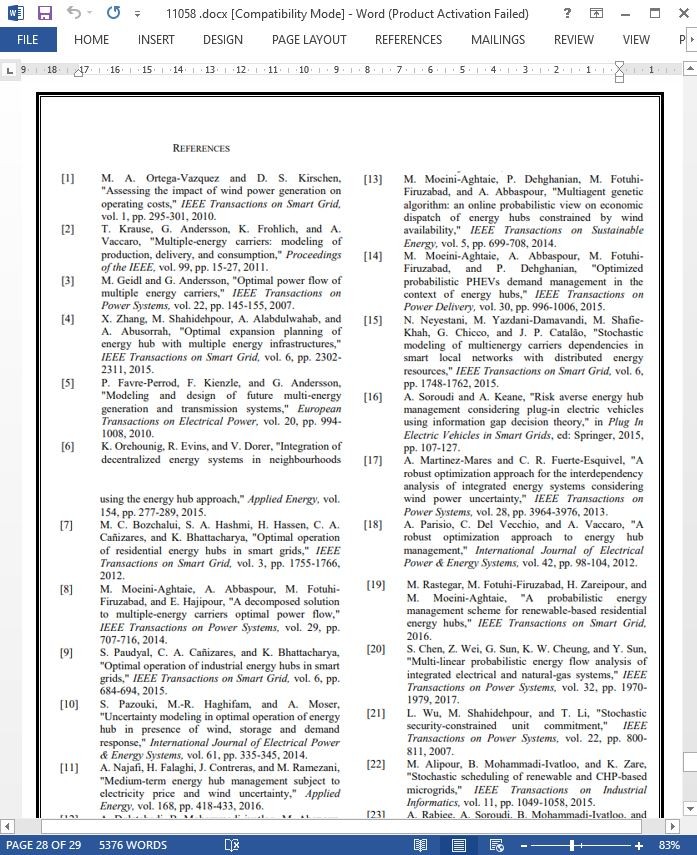
استراتژی زمان بندی کوتاه مدت برای هاب مبتنی بر انرژی باد
چکیده
این مقاله، مسئله زمانبندی در سیستم هاب انرژی را از طریق رویکرد تئوری تصمیم شکاف اطلاعات (IGDT)/تصادفی هیبریدی مورد ارزیابی قرار میدهد. این دستگاههای هاب متشکل از توربینهای بادی، واحدهای تجمیع شده توان و حرارت (CHP)، بویلرهای کمکی و دستگاههای ذخیرهسازی انرژی است. با فرض اینکه هاب انرژی بهعنوان اتصالی میان زیرساختهای انرژی مختلف نقشی غیرقابلانکار بازی میکند، هنوز بررسی این هاب ها از جنبههای مدلسازی و زمانبندی ضروری است. از سوی دیگر، در سالهای اخیر نفوذ تولید توان بادی در زیرساختهای انرژی بهطور چشمگیری افزایش پیداکرده است. به همین منظور، این مقاله برای زمانبندی بهینه در هاب انرژی یکپارچه بادی روی روش بهینهسازی IGDT/ تصادفی هیبریدی تمرکز کرده است. این کار با در نظرگیری عدم قطعیت تولید انرژی بادی، قیمت انرژی و تقاضا انرژی صورت گرفته است. روش ما به صورتی بوده است که نهتنها میتواند به راهحل بهینه جهانی دست پیدا کند بلکه حجم محاسبات نیز میتواند کمتر شود. علاوه بر این، اپراتور تاب انرژی توسط مدل هیبریدی ارائهشده میتواند برای مواجهه با عدم قطعیت قیمت، دو استراتژی مختلف را دنبال کند. برای مثال، استراتژی خطر جو و خطر گریز. این روش مسئله بهوسیله برنامهنویسی غیرخطی، یکپارچه و ترکیبی (MINLP) باعث بهینهسازی مسئله زمانبندی هاب انرژی در محیطی نامطمئن میشود. این فرمول سازی ارائه شدت است تا هزینه مورد انتظار در عملیات هاب انرژی را کمینه کند. چنین عملی درجایی رخ میدهد که تقاضاهای مختلف انرژی از هاب انرژی به صورتی کارآمد پاسخ داده میشود. خطاهای پیشبینی در مورد عدم قطعیتها مرتبط به تولید توان بادی است و تقاضا انرژی بهصورت یک سناریو مدلسازی شدهاند درحالیکه رویکرد بهینهسازی IGDT برای مدلسازی عدم قطعیت قیمت الکتریسیته ارائهشده است.
A. تعریف مسئله و انگیزه
هرچقدر که نفوذ منابع انرژی تجدید پذیر متناوب در زیرساخت انرژی افزایشی چشمگیر پیدا میکند، تناوب و تغییرپذیری تولید تجدید پذیر منجر به ایجاد چالشهایی بزرگ در زمانبندی زیرساخت انرژی میشود. در میان منابع انرژی تجدید پذیر، تولید بادی بخش قابلتوجهی از تولیدات تجدید پذیر را به خود اختصاص داده است. بهرهوری تعادل و هزینههای عملیاتی حاشیهای پایین علت چنین اتفاقی است. بااینحال، احتمال دارد که تأثیرات پیشبینی پذیری پایین و عدم قطعیت در تولید بادی و نیز تبدیل احتمال بالقوه در این نوع از منابع به راهحلی واقعی، توسط همگامسازی زیرساختهای انرژی مختلف کمتر شود. یک هاب انرژی میتواند بهعنوان یک رابط بین زیرساختهای مختلف انرژی مانند شبکههای الکتریسیته و گاز طبیعی تعریف شود. از سوی دیگر، یک هاب انرژی میتواند مصرف انرژی اولیه، انتشار متوالی آلایندهها و هزینه مصرف انرژی را کاهش دهد. اخیراً باهدف تأمین تقاضاهای انرژی درروشی اقتصادی، سازگار با محیطزیست و قابلاتکا، بهشدت روی برنامهریزی، عملیات و مدیریت انرژی در هاب انرژی تحقیقشده است. مسئله اصلی در طرحریزی و زمانبندی کارهای همراه با چنین تحقیقاتی در نظرگیری تأثیرات عدم قطعیت همراه باانرژی بادی، تقاضا انرژی و تعرفههای بازار انرژی است. بهطوریکه بتوان به تمام تقاضاهای انرژی پاسخ گفت درحالیکه هزینه تأمین انرژی مشتریان کمینه باشد.
IV. نتیجهگیری
در این مقاله، یک استراتژی زمانبندی برای یک سیستم هاب انرژی بر مبنای بهینهسازی IGDT/تصادفی ترکیبی ارائهشده است. خروجیهای غیرقطعی از تقاضاهای انرژی و تولید باد از طریق سناریوها مدلسازی شدهاند درحالیکه بهینهسازی IGDT برای دستیابی به حدفاصلی برای قیمت الکتریسیته پیادهسازی شده است. این موضوع در جهت مطالعه توابع موقعیت و مقاوم بوده است. اپراتور هاب انرژی توسط مدل ترکیبی ارائهشده میتواند استراتژیهای ریسک جو و ریسک گریز را بهمنظور مواجهه با عدم قطعیت قیمت رهگیری کند. بار محاسباتی مسئله با پیادهسازی روش بهینهسازی IGDT/تصادفی هیبریدی برای زمانبندی بهینه در هاب انرژی مجتمع بادی، افزایش پیدا میکند. درنهایت، نتایج عددی بهدستآمده از موارد مطالعه شده، تناسب و سودمندی روش ارائهشده را تصدیق مینمایند. نشان دادهشده که با پیادهسازی استراتژیهای مختلف ارائهشده توسط مدل IGDT/ تصادفی ترکیبی، مانند استراتژیهای ریسک جو و ریسک گریز میتوان درجه آزادی بیشتری برای اپراتور هاب انرژی در بازار انرژی تنظیمنشده مهیا کرد.
Abstract
This paper evaluates the scheduling problem for energy hub system consisting of wind turbine, combined heat and power units, auxiliary boilers, and energy storage devices via hybrid stochastic/information gap decision theory (IGDT) approach. Considering that energy hub plays an undeniable role as the coupling among various energy infrastructures, still it is essential to be investigated in both modeling and scheduling aspects. On the other hand, penetration of wind power generation is significantly increased in energy infrastructures in recent years. In response, this paper aims to focus on the hybrid stochastic/IGDT optimization method for the optimal scheduling of wind integrated energy hub considering the uncertainties of wind power generation, energy prices and energy demands explicitly in a way that not only global optimal solution can be reached, but also volume of computations can be lighten. In addition, by the proposed hybrid model, the energy hub operator can pursue two different strategies to face with price uncertainty, i.e., risk-seeker strategy and risk-averse strategy. This method optimizes energy hub scheduling problem in uncertain environment by mixed-integer nonlinear programming. This formulation is proposed to minimize the expected operation cost of energy hub where different energy demands of energy hub would be efficiently met. The forecast errors of uncertainties related to wind power generation and energy demands are modeled as a scenario, while an IGDT optimization approach is proposed to model electricity price uncertainty.
A. Motivation and Problem Description
As the penetration of intermittent renewable energy resources increase substantially in energy infrastructures, renewable generation intermittency and variability causes big challenges on energy infrastructure scheduling. Among the renewable energy resources, wind generation assigns a remarkable portion of the renewable generations, due to energy balance efficiency and low marginal operating costs [1]. However, one possibility to smooth the effect of limited predictability and uncertainty of wind generation as well as convert potential possibility of these kinds of resources into actual solutions is coordinating different energy infrastructures [2]. An energy hub can be defined as an interface between various energy infrastructures such as electricity and natural gas networks [3-5]. On the other hand, an energy hub can reduce consumption of primary energy, the sequential pollutant emissions and the cost of energy consumption [4, 6]. Towards the goal of supplying energy demands in an economical, environmentally friendly and reliable way, planning, operation, and energy management of energy hub systems have been extensively investigated recently. An essential problem of the associated planning and scheduling tasks is to consider the effect of uncertainties associated with wind power, energy demands and energy market tariffs so that total energy demands can be served, while the cost of serving energy to customers is minimized.
IV. CONCLUSION
In this paper, a scheduling strategy for an energy hub system based on hybrid stochastic/IGDT optimization is proposed. The uncertain outputs of wind generation and energy demands are modeled via scenarios, while an IGDT optimization is implemented to find an interval for electricity price to study the robustness and opportunity functions. By the proposed hybrid model, the energy hub operator can track risk-averse and risk-seeker strategies to face with price uncertainty. By implementing the hybrid stochastic/IGDT optimization method for the optimal scheduling of wind integrated energy hub, the computation burden of the problem is decreased. Finally, the numerical results obtained from the studied cases verified the appropriateness and usefulness of the proposed method, where it is shown that by applying different strategies such as risk-averse and risk-seeker strategies provided by hybrid stochastic/IGDT model grants additional degree of freedom in deregulated energy markets for energy hub operator.
چکیده
علائم
پارامترها
متغیرها
توابع
I. مقدمه
A. تعریف مسئله و انگیزه
B. مروری بر ادبیات علمی
C. مشارکتها
D. سازماندهی مقاله
II. زمانبندی هاب انرژی برمبنای بهینهسازی IGDT/تصادفی ترکیبی
A. استراتژی زمانبندی برمبنای برنامهریزی تصادفی
B. بهینهسازی IGDT/تصادفی هیبریدی
III. نتایج شبیهسازی و مباحثه
A. مطالعه موردی I: مثالی روشنگر
B. مطالعه موردی II: سیستم تغییر دادهشده آزمون 34 گرهای IEEE
C. مقایسه روش ترکیبی ارائهشده با رویکردهای تصادفی خالص و قطعی برای قیمتهای واقعی
IV. نتیجهگیری
Abstract
Indices
Parameters
Variables
Functions
I. INTRODUCTION
A. Motivation and Problem Description
B. Literature Review
C. Contributions
D. Paper Organization
II. ENERGY HUB SCHEDULING BASED ON HYBRID STOCHASTIC/IGDT OPTIMIZATION
A. Scheduling strategy based on stochastic programming
B. Hybrid Stochastic/IGDT Optimization
III. SIMULATION RESULTS AND DISCUSSIONS
A. Case Study I: An Illustrative Example
B. Case Study II: A modified IEEE 34-node test system
C. Comparison of proposed hybrid method with deterministic and pure stochastic approaches for actual prices
IV. CONCLUSION
- ترجمه فارسی مقاله با فرمت ورد (word) با قابلیت ویرایش، بدون آرم سایت ای ترجمه
- ترجمه فارسی مقاله با فرمت pdf، بدون آرم سایت ای ترجمه



